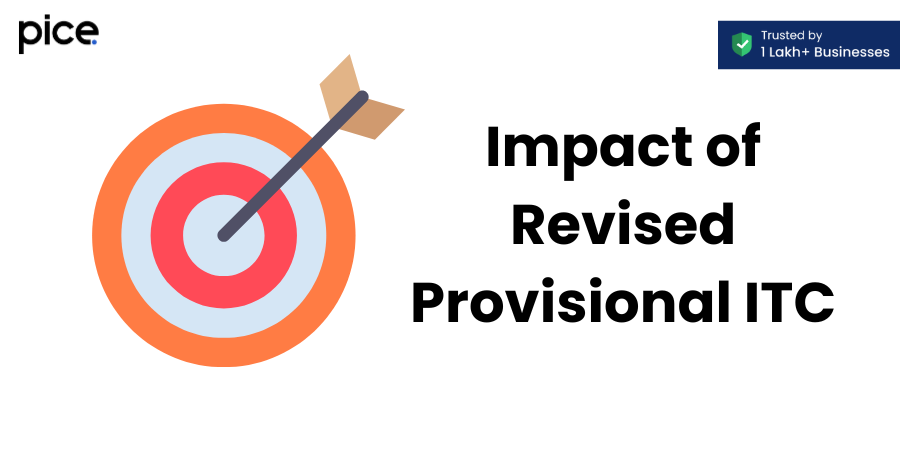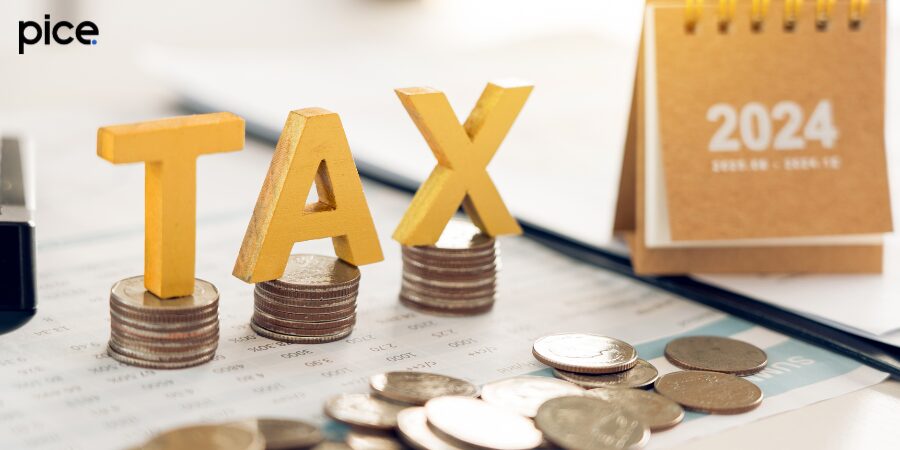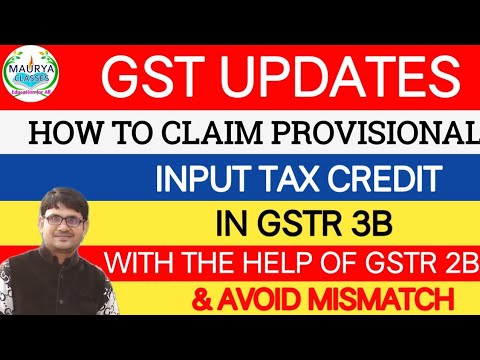Key Takeaways
- Provisional Input Tax Credit (ITC) allowed businesses to claim temporary credit based on purchase invoices, helping manage their tax liability and cash flow efficiently.
- The removal of provisional ITC requires taxpayers to rely solely on the credits available in GSTR-2A, enhancing the accuracy and compliance of ITC claims.
- To claim balance ITC accurately, taxpayers must ensure timely and accurate reporting by suppliers, maintain diligent reconciliation practices, and regularly monitor their GSTR-2A.
- The revised provisional ITC rule mandates that all ITC claims be based on credits reflected in GSTR-2A, reducing the scope for discrepancies and fraud.
- Maintaining up-to-date books of accounts and regular communication with suppliers are essential for ensuring that all eligible tax credits are claimed and utilized correctly.
What is Provisional ITC?
Input Tax Credit (ITC) is a fundamental aspect of the Goods and Services Tax (GST) system, designed to eliminate the cascading effect of taxes and allow businesses to claim credit for taxes paid on inputs. Provisional Input Tax Credit (ITC) refers to the temporary credit claimed by taxpayers based on the available purchase invoices before final validation through subsequent GST returns.
Provisional ITC was introduced to facilitate the immediate availment of credit, enabling businesses to maintain cash flow and manage their tax liabilities more effectively. Under this mechanism, businesses could claim a provisional credit of up to 20% of the eligible credit reflected in their GSTR-2A, which later got reduced to 10% and subsequently to 5%. This provisional credit was intended to bridge the gap until the supplier’s invoices were uploaded and validated through GSTR-1/IFF.
💡 If you want to pay your GST with Credit Card, then download Pice Business Payment App. Pice is the one stop app for all paying all your business expenses.
The claim process for Provisional ITC involved taxpayers self-assessing their credit eligibility based on the input tax credit provisions. Businesses needed to ensure that they possessed valid purchase invoices, which acted as the primary basis for claiming provisional credit. This process was crucial for businesses to optimize ITC usage and manage their GST liabilities efficiently.
However, provisional credit was subject to conditions. Taxpayers had to reconcile their claims with the actual credits available in GSTR-2A and make necessary adjustments in their subsequent GST returns. Any excess credit claimed provisionally but not supported by actual invoices led to adjustments or credit claim disallowance post-reconciliation. This process ensured that only eligible credits were utilized, preventing loss of credit due to ineligible claims.
The adoption by taxpayers of provisional ITC was significant, especially in industries with complex supply chains and high volume of transactions. Despite its benefits, the provisional credit system also posed challenges in terms of compliance and reconciliation, prompting a need for revised provisions and regulations.
Removal of Provisional ITC in GSTR-3B
The removal of provisional ITC from GSTR-3B marks a significant shift in the GST framework aimed at enhancing accuracy and compliance in tax credit claims. This change was brought about to address the challenges associated with the reconciliation of provisional credits and to ensure that only eligible input tax credits are availed by taxpayers.
The concept of provisional credit allowed taxpayers to claim ITC based on self-assessed estimates, often leading to discrepancies between claimed credits and actual credits reflected in GSTR-2A. This mismatch necessitated multiple reconciliations, increasing the compliance burden on businesses and the risk of tax credit disallowance.
With the removal of provisional ITC, taxpayers can now claim ITC strictly based on the credits available in GSTR-2A, which are uploaded by their suppliers. This ensures that only the credit applicable and verified through the supplier’s return is claimed, thereby reducing the chances of excess credit and improving the accuracy of ITC claims. The process involves ensuring that all purchase invoices are accurately reported by suppliers in their GSTR-1/IFF forms, which then reflect in the recipient’s GSTR-2A.
The impact of this change is multifaceted. On one hand, it reduces the administrative burden on taxpayers by eliminating the need for provisional credit claims and subsequent reconciliations. On the other hand, it places a greater responsibility on businesses to ensure timely and accurate reporting by their suppliers. Failure to do so can result in significant cash flow issues due to delayed ITC claims.
To facilitate this transition, the GST authorities have been emphasizing the importance of regular communication with suppliers and diligent tracking of tax credits. Taxpayers are now encouraged to adopt robust accounting and reconciliation practices to ensure that all eligible input tax credits are captured and utilized within the allowed tax period.
Overall, the removal of provisional ITC aims to streamline the GST return process, enhance the accuracy of ITC claims, and minimize the scope for discrepancies and fraud. It underscores the need for businesses to stay vigilant and proactive in managing their tax credits and compliance obligations.
Latest Update on Provisional ITC Rule
The latest update on the provisional ITC rule has brought about a notable change in the way taxpayers can claim and utilize input tax credits under GST. Previously, provisional credits allowed taxpayers to claim ITC based on self-assessed estimates, which has now been replaced by a more stringent rule requiring claims to be based solely on the credits reflected in GSTR-2A.
Provisional ITC Background
Initially, the provisional ITC rule permitted taxpayers to claim up to 20% of the eligible credit available in GSTR-2A as provisional credit, aimed at ensuring liquidity and continuity of business operations. This percentage was progressively reduced to 10% and later to 5%, reflecting the government’s intention to tighten the provisional credit claims and enhance the accuracy of the ITC availed by taxpayers.
However, provisional credit claims often led to mismatches between the credits claimed by recipients and the actual credits uploaded by suppliers in GSTR-1/IFF. This discrepancy resulted in extensive reconciliations, additional compliance burdens, and instances of credit claim disallowance post-reconciliation.
Impact of Revised Provisional ITC

The revised provisional ITC rule mandates that ITC claims must be entirely based on the credits available in GSTR-2A, as uploaded by the suppliers. This revision aims to eliminate the scope for discrepancies and ensure that only eligible input tax credits are availed by taxpayers, thereby enhancing the integrity and reliability of the GST system.
The impact on taxpayers is significant, as they now need to rely entirely on the accurate and timely reporting by their suppliers. This necessitates stronger communication channels and coordination with suppliers to ensure that all purchase invoices are correctly reported in the supplier’s returns.
Moreover, the revised rule places a greater emphasis on maintaining up-to-date books of accounts and diligent reconciliation practices. Taxpayers must regularly track their GSTR-2A to ensure all eligible credits are captured and any discrepancies are promptly addressed.
Background and Impact of Revised Provisional ITC
The background and impact of the revised provisional ITC rule highlight the government’s efforts to streamline the GST framework and enhance compliance. Initially, provisional ITC was introduced to provide immediate relief to taxpayers by allowing them to claim credits based on self-assessed estimates. This was particularly beneficial for businesses with complex supply chains and frequent transactions.
However, the provisional credit system posed several challenges. The reliance on self-assessed estimates often led to mismatches between the claimed credits and the actual credits available in GSTR-2A, necessitating multiple reconciliations and adjustments. This not only increased the compliance burden on businesses but also led to instances of excess credit claims and subsequent disallowances, impacting the financial stability of taxpayers.
Revised Provisional ITC Rule
To address these challenges, the government revised the provisional ITC rule, mandating that ITC claims must be based solely on the credits reflected in GSTR-2A. This revision ensures that only verified and eligible credits are claimed, reducing the scope for discrepancies and fraud.
The impact of this revision is twofold. Firstly, it simplifies the ITC claim process by eliminating the need for provisional credit claims and subsequent reconciliations. Taxpayers can now rely on the credits available in GSTR-2A, ensuring greater accuracy and compliance.
Secondly, it places a greater responsibility on businesses to ensure timely and accurate reporting by their suppliers. Taxpayers must maintain regular communication with their suppliers to ensure that all purchase invoices are correctly reported in GSTR-1/IFF. Failure to do so can result in delayed ITC claims and potential cash flow issues.
Overall, the revised provisional ITC rule aims to enhance the integrity and reliability of the GST system, ensuring that only eligible credits are availed by taxpayers and minimizing the scope for discrepancies and fraud.
How Could the Taxpayers Claim Balance ITC?
With the revised provisional ITC rule, taxpayers must adopt diligent practices to claim balance ITC accurately and efficiently. The key to claiming balance ITC lies in ensuring timely and accurate reporting by suppliers and maintaining robust reconciliation practices.
Steps to Claim Balance ITC
- Regular Communication with Suppliers: Establish regular communication with suppliers to ensure that all purchase invoices are correctly reported in their GSTR-1/IFF. This ensures that the credits are reflected in GSTR-2A, enabling taxpayers to claim the eligible ITC.
- Diligent Reconciliation: Conduct regular reconciliations of the purchase invoices with the credits available in GSTR-2A. This helps in identifying any discrepancies and addressing them promptly, ensuring that the claimed credits are accurate and eligible.
- Timely Filing of Returns: Ensure timely filing of GST returns, including GSTR-3B and annual returns. This not only ensures compliance but also helps in tracking and claiming the eligible ITC within the allowed tax period.
- Maintaining Up-to-Date Books of Accounts: Maintain accurate and up-to-date books of accounts, reflecting all purchase invoices and credits. This helps in ensuring that all eligible credits are captured and utilized efficiently.
- Regular Monitoring of GSTR-2A: Regularly monitor GSTR-2A to track the credits available and identify any discrepancies. This helps in ensuring that all eligible credits are claimed and utilized within the allowed period.
By adopting these practices, taxpayers can ensure that they claim the balance ITC accurately and efficiently, optimizing their tax credits and maintaining compliance with GST regulations.
FAQs
What happens if a taxpayer claims extra credit in their GST return?
If a taxpayer claims extra credit beyond the eligible tax credits reflected in their GSTR-2A, this excess credit will be disallowed during the reconciliation process. This can result in a tax liability for the taxpayer, as they will need to pay back the disallowed amount along with any applicable interest or penalties.
How should registered taxpayers handle discrepancies in credit on invoices?
Registered taxpayers should regularly reconcile their purchase invoices with the credits reflected in GSTR-2A. If discrepancies are found, they should communicate with their suppliers to ensure the correct reporting of invoices in their GSTR-1/IFF. Timely reconciliation and correction help avoid issues with claiming eligible tax credits.
Can provisional ITC be claimed on ineligible credit?
No, provisional ITC cannot be claimed on ineligible credit. Ineligible credits include those related to personal expenses, exempt supplies, and items not used for business purposes. Taxpayers must ensure that their claims are restricted to eligible tax credits to comply with GST regulations.
What are the implications for taxpayer filing if they miss claiming eligible tax credits within the allowed period?
If taxpayers miss claiming eligible tax credits within the allowed tax period, they may lose the ability to claim those credits entirely. This can increase their overall tax liability as they will not be able to offset their GST payable with these missed credits, impacting their cash flow and financial planning.
How does the removal of provisional ITC affect credit in terms of tax compliance?
The removal of provisional ITC requires taxpayers to rely strictly on the credits available in GSTR-2A, ensuring more accurate and compliant tax filings. This change minimizes discrepancies and the risk of claiming ineligible credits, leading to better tax compliance and reducing the need for subsequent adjustments.
What steps can taxpayers take to ensure they are claiming all eligible tax credits?
Taxpayers should maintain diligent records of all purchase invoices, ensure timely filing of supplier returns, and regularly reconcile their books with GSTR-2A. They should also stay informed about any changes in GST regulations to ensure all their claims are compliant and complete.
How does claiming provisional ITC impact a taxpayer’s tax liability?
Claiming provisional ITC can temporarily reduce a taxpayer’s tax liability by allowing them to offset their GST payable with the claimed credit. However, if the provisional credit is later found to be in excess or ineligible, it can lead to increased tax liability due to required repayments and potential penalties.








